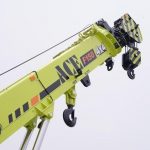
The CT-1120 form is used by corporations to report business taxes in Connecticut, covering both net income and capital stock tax. Electronic filing is mandatory for all corporations, ensuring compliance with state tax laws. The instructions guide taxpayers through filing requirements, deadlines, and payment options, helping to avoid penalties; Taxpayers can access detailed instructions and forms through the Connecticut Department of Revenue Services website, ensuring accurate and timely submissions. Overpayments may be applied to future estimated taxes, simplifying tax management for businesses.
Overview of the CT-1120 Form
The CT-1120 form is used by corporations to report and pay Connecticut business taxes. It calculates tax on net income and capital stock, with electronic filing required. Corporations must include Schedule A for net income computation and Form CT-1120A for apportionment. Additional schedules may be needed for specific deductions or credits. The form ensures compliance with state tax laws, covering filing requirements, payment options, and necessary documentation for accurate submissions.
Importance of Following the Instructions
Adhering to the CT-1120 instructions ensures accurate and timely filing, avoiding penalties and interest. Correctly completing the form helps in proper tax computation, including net income and capital stock tax. Following guidelines ensures compliance with Connecticut tax laws and facilitates electronic submissions. Proper documentation and schedule attachments prevent delays. Overpayments can be applied to future taxes if instructions are followed, simplifying tax management and maintaining good standing with the state.
Key Changes for the 2022 Tax Year
The 2022 CT-1120 instructions introduced updates to streamline filing processes. Overpayments of tax liability could now be applied to the first 2023 estimated tax installment. Mandatory electronic filing and payment options were emphasized to enhance compliance. Additionally, updates to Schedule A and Form CT-1120A ensured accurate apportionment of income for multi-state corporations, reflecting changes in tax law and reporting requirements for the 2022 tax year.

Who Needs to File CT-1120?
Corporations, associations taxable as corporations, and businesses operating in Connecticut must file Form CT-1120 to report their income and comply with state tax requirements annually.
C Corporations and Associations Taxable as Corporations
C corporations and associations taxable as corporations must file Form CT-1120 annually to report their income and compute taxes. This includes domestic and foreign corporations operating in Connecticut, ensuring compliance with state tax laws. The form requires reporting income, computing tax on net income, and calculating capital stock tax. Associations treated as corporations for tax purposes are also obligated to file, adhering to Connecticut’s corporate tax regulations and deadlines to avoid penalties.
Businesses Operating in Connecticut
Businesses operating in Connecticut, including those incorporated elsewhere, must file Form CT-1120 if they conduct activities or have the right to operate within the state. This applies to corporations and associations taxable as corporations, ensuring they meet Connecticut’s tax requirements. The form covers both in-state and multi-state income, with specific guidelines for apportionment and combined reporting. Compliance with filing deadlines and electronic submission through myconneCT is mandatory to avoid penalties and maintain tax compliance effectively.
Special Rules for S Corporations and Pass-Through Entities
S Corporations and pass-through entities must adhere to specific guidelines when filing Form CT-1120. While these entities typically pass income to shareholders, Connecticut requires them to file annually; Pass-through entities may need to complete additional forms, such as CT-1065, and report income apportioned to Connecticut. Electronic filing is mandatory, and payments must be made through myconneCT. Special rules apply to ensure compliance with state tax laws, avoiding penalties and ensuring accurate reporting of pass-through income and credits.

Key Deadlines for CT-1120 Filing
Corporations must file Form CT-1120 by May 15, 2023. Late filings incur penalties and interest. Extensions may be requested using Form CT-1120 EXT, granting additional time.
Filing Deadline for the 2022 Tax Year
The filing deadline for the 2022 CT-1120 form is May 15, 2023. Corporations must file and pay taxes by this date to avoid penalties and interest. Late filings may result in additional fees. If the due date falls on a weekend or federal holiday, the deadline is the next business day. Taxpayers can request a six-month extension using Form CT-1120 EXT. Overpayments from 2022 may be applied to the first 2023 estimated tax installment if timely filed. Ensure timely submission to maintain compliance with Connecticut tax laws.
Payment Deadline and Late Payment Penalties
The payment deadline for the 2022 CT-1120 tax year is May 15, 2023. All corporations must pay taxes by this date to avoid penalties and interest. Late payments incur a penalty of up to 25% of the unpaid amount, plus interest. Electronic payment is mandatory for all corporations. Overpayments from 2022 can be applied to the first 2023 estimated tax installment if filed timely. Ensure timely payment to avoid additional fees and maintain compliance with Connecticut tax regulations.
Requesting an Extension of Time to File
Use Form CT-1120 EXT to request a six-month extension for filing the CT-1120. The extension must be filed by the original deadline to avoid penalties. An extension grants additional time to file but does not extend the payment deadline. Electronic filing through myconneCT is required. Overpayments from 2022 can be applied to 2023 estimated taxes. Ensure the extension is submitted timely to maintain compliance and avoid late filing penalties. Penalties and interest apply to unpaid amounts after the original deadline.

Filing Methods for CT-1120
Corporations must file electronically using the myconneCT system or by mail with a postmark by the deadline. Use Form CT-1120 for timely submissions and avoid penalties.
Electronic Filing Requirements
Electronic filing is mandatory for all corporations in Connecticut. Use the myconneCT system to file and pay taxes online. Ensure all attachments and schedules are submitted electronically. This method streamlines the process, reduces errors, and provides confirmation of submission. Corporations must comply with this requirement to avoid penalties. The myconneCT system also allows users to manage state tax responsibilities efficiently, making it the preferred method for timely and accurate submissions. Electronic filing ensures compliance with Connecticut tax regulations and simplifies recordkeeping for businesses.
Mail Filing Procedures
Corporations may file Form CT-1120 by mail if required. Ensure the return is postmarked by the deadline to avoid penalties. Mail the completed form and all required attachments to the address listed in the instructions. Use certified mail for proof of delivery. While mail filing is an option, electronic filing is preferred and mandatory for payments. Check the Connecticut Department of Revenue Services website for the correct mailing address and any updated procedures. Mail filing is less common but remains a viable option for those unable to file electronically.
Using the myconneCT System for Tax Filing
The myconneCT system is Connecticut’s official online platform for tax filing, payments, and account management. It allows corporations to electronically file Form CT-1120, make payments, and view filing statuses. Taxpayers can access the system 24/7, ensuring convenience and efficiency. Mandatory for corporations, electronic filing through myconneCT streamlines the process and reduces errors. Users can also maintain records and receive real-time confirmation of submissions. Visit the Connecticut Department of Revenue Services website for step-by-step instructions and support for using myconneCT.

Tax Computation and Payment
Corporations compute tax on net income and capital stock. Mandatory electronic payments ensure timely filing. Use myconneCT for secure submissions and real-time confirmation of tax payments.
Computing Tax on Net Income
Corporations calculate tax on net income by reporting gross income, deducting allowable expenses, and applying Connecticut tax rates. Schedule A is used to compute this tax. Include federal taxable income, modifications, and apportionment if applicable. Net income tax is mandatory, with rates varying based on taxable income levels. Ensure accurate reporting to avoid penalties. Electronic filing via myconneCT is required for timely submissions. Refer to specific instructions for detailed computation steps and applicable tax rates for the 2022 tax year.
Capital Stock Tax Calculation
The capital stock tax is based on the corporation’s capital assets, including real and tangible personal property. The tax rate applies to the average net capital stock during the tax year. Corporations must report the value of their capital stock and apportion it if operating in multiple states. This tax is separate from the net income tax and must be calculated accurately to avoid penalties. Use the specific line on Form CT-1120 for capital stock tax reporting; Ensure compliance with electronic filing requirements for timely submissions. Consult the instructions for detailed valuation methods and applicable rates.
Apportionment of Income for Multi-State Corporations
Multi-state corporations must apportion income based on Connecticut’s three-factor formula: payroll, property, and sales. Each factor represents a percentage of the total, with sales weighted at 50%. Corporations use Form CT-1120A to compute apportionment. Special rules apply for certain industries. Electronic filing is required. Ensure accurate calculations to avoid penalties and comply with state tax regulations. This step ensures fair distribution of taxable income across operating states, aligning with Connecticut’s tax laws and reporting requirements. Proper documentation is essential for audit purposes.
Combined Reporting for Corporate Groups
Corporate groups must file a combined report to ensure proper allocation of income and taxes. This method prevents tax avoidance by treating the group as a single entity. All members must be included, and specific rules apply to intercompany transactions. Form CT-1120 is used for combined reporting, with detailed schedules to outline each member’s share. Compliance with Connecticut’s tax laws is crucial to avoid penalties. Proper documentation and accurate calculations ensure fair distribution of tax liabilities among group members, maintaining transparency and regulatory adherence.

Credits and Deductions
Credits like Research and Development and other business tax credits reduce liability. Deductions for net operating losses also apply, ensuring accurate tax computation and compliance with state regulations.
Research and Development Tax Credits
Corporations may claim Research and Development (R&D) tax credits for qualified expenditures. Attach Form CT-1120RC or CT-1120 RDC to the CT-1120 return. These credits reduce tax liability, encouraging innovation. Eligible expenses include wages, supplies, and contracted research; Documentation must support the claimed expenditures. This incentive helps businesses investing in R&D activities, aligning with state goals to foster economic growth and technological advancement. Proper calculation ensures compliance with Connecticut tax regulations.
Other Available Business Tax Credits
Besides R&D credits, businesses may qualify for additional tax incentives. Connecticut offers credits for hiring veterans, individuals with disabilities, and investments in green technologies. Attach Form CT-1120ATT for electronic filing compliance. Credits for renewable energy projects and historic preservation are also available. These incentives aim to promote economic growth and sustainability. Ensure proper documentation and eligibility criteria are met. Refer to the Connecticut Department of Revenue Services for detailed guidelines on claiming these credits effectively.
Net Operating Loss (NOL) Deductions
Corporations may claim Net Operating Loss (NOL) deductions to reduce taxable income. For tax year 2022, NOLs can offset up to 80% of taxable income. Attach Form CT-1120ATT for electronic filing compliance. Proper documentation, such as financial statements and supporting schedules, is required to validate NOL claims. Ensure accurate calculation and reporting to avoid penalties. Refer to the Connecticut Department of Revenue Services for specific guidelines on NOL deductions and eligibility criteria. Timely filing ensures compliance with state tax regulations and optimizes tax savings.

Required Forms and Schedules
Form CT-1120 is the primary form for corporation business tax. Schedule A computes tax on net income, while Form CT-1120A handles apportionment. Additional schedules and attachments may be required based on specific circumstances.
Form CT-1120 and Its Components
Form CT-1120 is the primary document for reporting corporate income and taxes in Connecticut. It includes Schedule A for net income computation and Form CT-1120A for apportionment. Attachments like Form CT-1120RC for research credits and Form CT-1120 RDC for development credits may be required. The form also includes sections for deductions, tax credits, and capital stock tax calculations. Supporting documentation, such as financial statements and receipts, must accompany the form to ensure compliance with state tax regulations. Accurate completion is essential for proper tax assessment.
Schedule A ー Computation of Tax on Net Income
Schedule A is used to calculate the tax on a corporation’s net income for Connecticut. It begins with federal taxable income, adjusts for state-specific modifications, and applies apportionment if applicable. Corporations must report income from all sources, including business activities within Connecticut. Deductions and credits, such as research and development credits, are applied here. The computed tax is then compared to the minimum tax to determine the final liability. Accurate completion ensures proper tax calculation and compliance with state regulations.
Form CT-1120A ⸺ Apportionment Computation
Form CT-1120A is used to compute the apportionment of income for corporations operating in multiple states. It calculates the percentage of income taxable in Connecticut based on property, payroll, and sales factors. Corporations must report these factors and apply the appropriate apportionment formula. This form ensures that only the portion of income attributable to Connecticut is subject to state tax. Accurate completion is essential for compliance and to avoid penalties related to income allocation errors.
Additional Schedules and Attachments
Additional schedules and attachments are required to support the information reported on Form CT-1120. Schedule A is used to compute tax on net income, while Form CT-1120A is for apportionment calculations. Other schedules, such as CT-1120RC for research and development credits, must be attached if applicable. Supporting documentation, like receipts or invoices, may also be required. Ensure all attachments are properly completed and submitted to avoid delays or penalties. Electronic filing requires accurate upload of these documents through the myconneCT system.
Electronic Filing Requirements
Electronic filing is mandatory for all corporations. Use the myconneCT system to file, pay, and manage state tax responsibilities online for CT-1120 accurately.
Mandatory Electronic Filing for Corporations
All corporations must file Form CT-1120 electronically using the myconneCT system. This requirement ensures efficient processing and compliance with Connecticut tax laws. Taxpayers can easily submit their returns, make payments, and manage their accounts online. Electronic filing reduces errors and expedites refunds, providing a seamless experience for businesses. Corporations are required to pay taxes electronically as well, making the entire process digital and streamlined for accuracy and convenience.
Using the myconneCT System for Tax Payments
The myconneCT system offers a convenient platform for corporations to file and pay taxes electronically. Taxpayers can submit Form CT-1120, make payments, and manage their tax accounts securely online. This system streamlines the tax process, reducing errors and processing time. Payments can be made via ACH debit or credit card, with immediate confirmation. Using myconneCT ensures compliance with electronic filing requirements and provides a user-friendly experience for businesses to meet their tax obligations efficiently.
Electronic Payment Options
Corporations can make electronic payments for CT-1120 taxes using ACH debit or credit card through the myconneCT system. This method ensures timely and secure payments, reducing processing delays. Payments are immediately confirmed, providing peace of mind. Taxpayers can schedule payments in advance or make same-day payments. Electronic payments are mandatory for all corporate tax obligations, ensuring compliance with state tax requirements. This option streamlines the payment process, reducing errors and improving efficiency for businesses.

Estimated Tax Payments
Estimated tax payments are required for corporations expecting to owe $1,000 or more in taxes for the year. Use Form CT-1120 ES to make quarterly payments.
Form CT-1120 ES ー Estimated Tax Payment Voucher
Form CT-1120 ES is used by corporations to make quarterly estimated tax payments. Corporations expecting to owe $1,000 or more in taxes annually must file this voucher. Payments are due in April, June, September, and January of the following year. Overpayments may be applied to future installments. Taxpayers must submit this form electronically via the myconneCT system, ensuring timely compliance with Connecticut’s tax requirements. Proper completion helps avoid penalties and ensures accurate tracking of tax obligations throughout the year.
Due Dates for Estimated Tax Payments
Estimated tax payments for Connecticut corporations are due in four installments: April 15th, June 15th, September 15th, and January 15th of the following year. These dates apply to corporations operating on a calendar year. Taxpayers must use Form CT-1120 ES to make these payments. Meeting these deadlines ensures compliance with state tax requirements and avoids potential penalties. Corporations with a fiscal year must adjust due dates accordingly. Timely payments help manage tax obligations efficiently throughout the year.
Calculating Estimated Tax Liability
Estimated tax liability for Connecticut corporations is calculated using Form CT-1120 ES. Corporations must estimate their annual tax liability and make quarterly payments. The calculation is based on the corporation’s net income and capital stock tax. Taxpayers can use the prior year’s tax as a safe harbor to avoid penalties. For corporations with varying income, the annualized income method may be used. Payments must be made electronically through the myconneCT system or by mail using Form CT-1120 ES vouchers. Accurate calculations ensure compliance and prevent underpayment penalties.

Special Considerations
Special considerations include amended returns, pass-through entities, penalties, and recordkeeping requirements. Ensure compliance with all state tax laws and regulations for accurate and timely filings. Avoid penalties by adhering to deadlines and maintaining proper documentation for all transactions and tax-related decisions.
Taxation of Pass-Through Entities
Pass-through entities, such as S corporations and partnerships, do not pay taxes at the entity level but pass income to members. Connecticut requires these entities to file Form CT-1120SI. The pass-through entity tax applies to certain income types, with members reporting their share on individual returns. Optional payments can reduce members’ tax liabilities. Specific rules and deductions apply, ensuring compliance with state tax regulations. Proper documentation and timely filings are essential to avoid penalties and ensure accurate tax reporting for all pass-through entities operating in Connecticut.
Amended Returns and Adjustments
Corrections to a filed CT-1120 require submitting Form CT-1120X. This form allows taxpayers to adjust income, deductions, or credits. Supporting documentation must accompany the amended return to explain changes. Taxpayers should file electronically and ensure all adjustments align with federal changes. Amended returns can result in additional tax, refunds, or no change. Clear explanations and accurate recalculations are essential to avoid further scrutiny. Timely filing ensures compliance and prevents unnecessary penalties or interest accrual. Proper documentation supports the validity of adjustments made.
Penalties and Interest on Late Filings
Failing to file or pay on time results in penalties and interest. A 10% penalty applies to unpaid taxes, with interest accruing monthly. Even if taxes are paid electronically, late filing incurs penalties. Overpayments from prior years may offset current liabilities. Timely filing and payment are crucial to avoid additional charges. Penalties and interest increase the total tax liability, emphasizing the importance of meeting deadlines. Proper planning and compliance ensure a smoother tax process for corporations.
Recordkeeping and Documentation Requirements
Accurate recordkeeping is essential for compliance with CT-1120 filing requirements. Corporations must maintain detailed records supporting tax calculations, including income statements, expense ledgers, and apportionment data. Proper documentation ensures accurate reporting and facilitates audits. Records should include copies of tax returns, payment receipts, and supporting schedules. Adequate documentation helps verify tax positions and avoid disputes. Corporations must retain records for at least three years, as required by state tax laws. Proper organization of records simplifies the filing process and ensures compliance with all tax obligations.

Additional Resources
The Connecticut Department of Revenue Services offers comprehensive guides and contact support. Utilize online tools for filing assistance and consider professional tax consultants for complex scenarios.
Connecticut Department of Revenue Services Contact Information
The Connecticut Department of Revenue Services (DRS) provides support for CT-1120 filers through its official website and customer service. Taxpayers can access forms, instructions, and online tools at portal.ct.gov/DRS. For assistance, call the DRS at (860) 297-5962 or visit their office at 450 Columbus Blvd., Hartford, CT 06103. Additional resources, including FAQs and tax workshops, are available to help businesses navigate the filing process efficiently.
Online Tools and Guides for CT-1120 Filing
The Connecticut Department of Revenue Services offers various online tools to simplify the CT-1120 filing process. Taxpayers can use the myconneCT system to file electronically, pay taxes, and manage their accounts. Additionally, the DRS website provides downloadable forms, step-by-step instructions, and video tutorials. Interactive guides and FAQs are available to address common questions, ensuring accurate and efficient filing. These resources help businesses navigate the tax process seamlessly, reducing errors and saving time.
Professional Assistance and Tax Consultants
Engaging tax professionals or consultants is crucial for ensuring accurate CT-1120 filings, especially for complex cases. Experts can navigate intricate tax laws, optimize credits, and avoid penalties. The Connecticut Department of Revenue Services recommends consulting certified public accountants or tax attorneys for tailored advice. Professional assistance is particularly beneficial for multi-state corporations or businesses with unique tax scenarios. Additionally, tax consulting firms offer guidance on compliance, deductions, and apportionment, ensuring businesses meet all requirements efficiently and effectively. Staying informed with professional help is key to seamless tax filing.
The CT-1120 instructions guide corporations through accurate tax filings. Electronic filing ensures compliance, and adhering to deadlines avoids penalties. Professional advice aids in navigating complex tax requirements.
Final Tips for Accurate and Timely Filing
Ensure all necessary documentation is gathered before filing. Double-check calculations for accuracy and verify deadlines to avoid penalties. Use electronic filing for faster processing and confirm payment methods in advance. Review the form for any errors or missing information.Consult the Connecticut Department of Revenue Services website for updates or seek professional advice if needed. Overpayments from 2022 can be applied to 2023 estimated taxes, simplifying future filings. Stay organized and plan ahead to meet the May 15, 2023, deadline for the 2022 tax year.
Staying Informed About Tax Law Changes
Regularly check the Connecticut Department of Revenue Services website for updates on tax law changes affecting the CT-1120 form. Subscribe to official publications or newsletters to stay informed. Tax laws and filing requirements can change annually, impacting deadlines, credits, and deductions. Failing to stay updated may result in penalties or missed opportunities for tax savings. Ensure compliance by reviewing the latest instructions and seeking professional advice if needed. This helps maintain accuracy and ensures timely submission of your corporate tax return.




